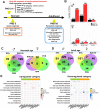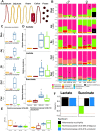Neonatal Exposure to BPA, BDE-99, and PCB Produces Persistent Changes in Hepatic Transcriptome Associated With Gut Dysbiosis in Adult Mouse Livers
- PMID: 34453844
- PMCID: PMC8557404
- DOI: 10.1093/toxsci/kfab104
Neonatal Exposure to BPA, BDE-99, and PCB Produces Persistent Changes in Hepatic Transcriptome Associated With Gut Dysbiosis in Adult Mouse Livers
Abstract
Recent evidence suggests that complex diseases can result from early life exposure to environmental toxicants. Polybrominated diphenyl ethers (PBDEs), and polychlorinated biphenyls (PCBs) are persistent organic pollutants (POPs) and remain a continuing risk to human health despite being banned from production. Developmental BPA exposure mediated-adult onset of liver cancer via epigenetic reprogramming mechanisms has been identified. Here, we investigated whether the gut microbiome and liver can be persistently reprogrammed following neonatal exposure to POPs, and the associations between microbial biomarkers and disease-prone changes in the hepatic transcriptome in adulthood, compared with BPA. C57BL/6 male and female mouse pups were orally administered vehicle, BPA, BDE-99 (a breast milk-enriched PBDE congener), or the Fox River PCB mixture (PCBs), once daily for three consecutive days (postnatal days [PND] 2-4). Tissues were collected at PND5 and PND60. Among the three chemicals investigated, early life exposure to BDE-99 produced the most prominent developmental reprogramming of the gut-liver axis, including hepatic inflammatory and cancer-prone signatures. In adulthood, neonatal BDE-99 exposure resulted in a persistent increase in Akkermansia muciniphila throughout the intestine, accompanied by increased hepatic levels of acetate and succinate, the known products of A. muciniphila. In males, this was positively associated with permissive epigenetic marks H3K4me1 and H3K27, which were enriched in loci near liver cancer-related genes that were dysregulated following neonatal exposure to BDE-99. Our findings provide novel insights that early life exposure to POPs can have a life-long impact on disease risk, which may partly be regulated by the gut microbiome.
Keywords: adverse health outcomes; bioinformatics; environmental chemicals; epigenetic; microbiome; toxicogenomics.
© The Author(s) 2021. Published by Oxford University Press on behalf of the Society of Toxicology. All rights reserved. For permissions, please e-mail: journals.permissions@oup.com.
Figures





Similar articles
-
Single-cell transcriptomics unveiled that early life BDE-99 exposure reprogrammed the gut-liver axis to promote a proinflammatory metabolic signature in male mice at late adulthood.Toxicol Sci. 2024 Jun 26;200(1):114-136. doi: 10.1093/toxsci/kfae047. Toxicol Sci. 2024. PMID: 38648751 Free PMC article.
-
Regulation of protein-coding gene and long noncoding RNA pairs in liver of conventional and germ-free mice following oral PBDE exposure.PLoS One. 2018 Aug 1;13(8):e0201387. doi: 10.1371/journal.pone.0201387. eCollection 2018. PLoS One. 2018. PMID: 30067809 Free PMC article.
-
Novel Interactions between Gut Microbiome and Host Drug-Processing Genes Modify the Hepatic Metabolism of the Environmental Chemicals Polybrominated Diphenyl Ethers.Drug Metab Dispos. 2017 Nov;45(11):1197-1214. doi: 10.1124/dmd.117.077024. Epub 2017 Sep 1. Drug Metab Dispos. 2017. PMID: 28864748 Free PMC article.
-
Persistent organic pollutants in foods, their interplay with gut microbiota and resultant toxicity.Sci Total Environ. 2022 Aug 1;832:155084. doi: 10.1016/j.scitotenv.2022.155084. Epub 2022 Apr 6. Sci Total Environ. 2022. PMID: 35395291 Review.
-
Inflammation and cardiometabolic diseases induced by persistent organic pollutants and nutritional interventions: Effects of multi-organ interactions.Environ Pollut. 2023 Dec 15;339:122756. doi: 10.1016/j.envpol.2023.122756. Epub 2023 Oct 14. Environ Pollut. 2023. PMID: 37844865 Free PMC article. Review.
Cited by
-
Development of Heterocyclic PPAR Ligands for Potential Therapeutic Applications.Pharmaceutics. 2022 Oct 8;14(10):2139. doi: 10.3390/pharmaceutics14102139. Pharmaceutics. 2022. PMID: 36297575 Free PMC article. Review.
-
Single-cell transcriptomics unveiled that early life BDE-99 exposure reprogrammed the gut-liver axis to promote a proinflammatory metabolic signature in male mice at late adulthood.Toxicol Sci. 2024 Jun 26;200(1):114-136. doi: 10.1093/toxsci/kfae047. Toxicol Sci. 2024. PMID: 38648751 Free PMC article.
-
Toxic Effects and Mechanisms of Polybrominated Diphenyl Ethers.Int J Mol Sci. 2023 Aug 30;24(17):13487. doi: 10.3390/ijms241713487. Int J Mol Sci. 2023. PMID: 37686292 Free PMC article. Review.
-
RISING STARS: Sex differences in toxicant-associated fatty liver disease.J Endocrinol. 2023 Jun 16;258(1):e220247. doi: 10.1530/JOE-22-0247. Print 2023 Jul 1. J Endocrinol. 2023. PMID: 37074385 Free PMC article. Review.
-
Single-cell transcriptomics showed that maternal PCB exposure dysregulated ER stress-mediated cell type-specific responses in the liver of female offspring.bioRxiv [Preprint]. 2025 Jun 8:2025.06.04.657944. doi: 10.1101/2025.06.04.657944. bioRxiv. 2025. PMID: 40501930 Free PMC article. Preprint.
References
-
- Albert O., Huang J. Y., Aleksa K., Hales B. F., Goodyer C. G., Robaire B., Chevrier J., Chan P. (2018). Exposure to polybrominated diphenyl ethers and phthalates in healthy men living in the greater Montreal area: A study of hormonal balance and semen quality. Environ. Int. 116, 165–175. - PubMed
-
- Alexa A., Rahnenfuhrer J. (2020). topGO: Enrichment Analysis for Gene Ontology. R package version 2.42.0.
-
- Almeida D. L., Pavanello A., Saavedra L. P., Pereira T. S., de Castro-Prado M. A. A., de Freitas Mathias P. C. (2019). Environmental monitoring and the developmental origins of health and disease. J. Dev. Orig. Health Dis. 10, 608–615. - PubMed
Publication types
MeSH terms
Substances
Grants and funding
LinkOut - more resources
Full Text Sources

